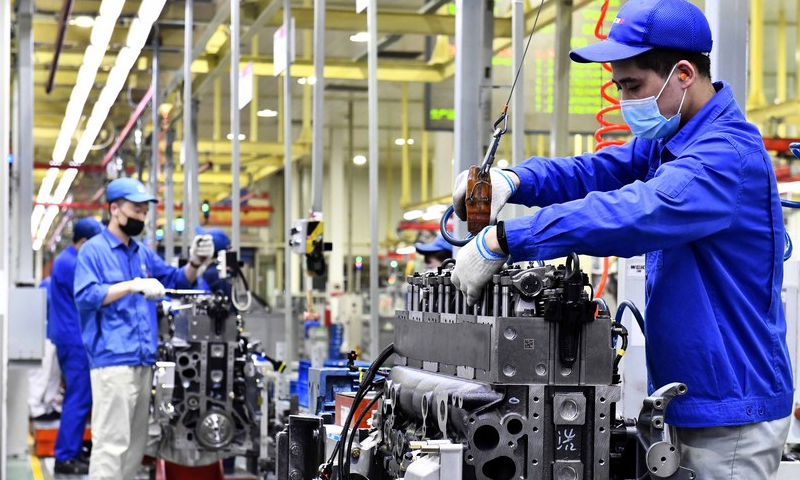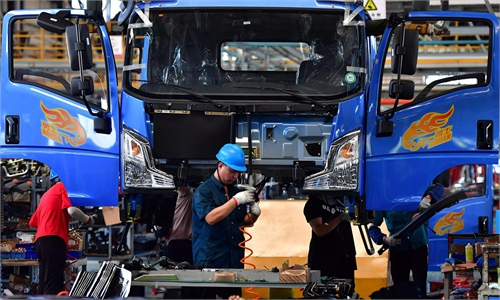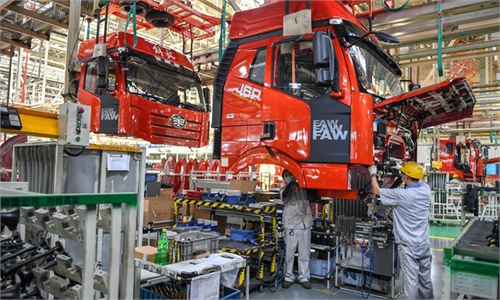
Workers assemble engines on an assembly line at a workshop of the Weichai Power Co., Ltd. in Weifang City, east China's Shandong Province, April 22, 2021. Photo: Xinhua
China's official manufacturing purchasing managers' index (PMI) in October came in at 49.2, falling into contraction range after the expansion in September, data from the National Bureau of Statistics (NBS) showed on Monday.The reading was 0.9 points lower than 50.1 in September, NBS data showed. The 50-point mark separates growth from contraction.
The reading dropped in October due to more frequent flare-ups of COVID-19, and the economic recovery needs further consolidation, NBS senior statistician Zhao Qinghe was quoted as saying in a statement on the website of the NBS on Monday.
Sub-indexes showed slowing activity in demand and production due to soaring raw material prices, experts said.
In October, the production index reached 49.6, down 1.9 points from September. On the demand side, the new order index was 48.1, down 1.7 points from the previous month.
Falling new orders in October reflected slowing domestic demand and pressure caused by raw material costs on enterprises, Zhou Maohua, an economist at Everbright Bank, told the Global Times on Monday.
Overall purchasing prices for raw materials in manufacturing sector continued to rise.
The purchasing price index of major raw materials stood at 53.3, up 2.0 points, and the factory-gate price index was 48.7, up 1.6 points from the previous month, the NBS said.
Also, the seven-day National Day holidays in October caused a slowdown in production, Zhou said.
Although the manufacturing PMI fell into contraction range in October, most industries have a stable outlook. Expectations for production and the operation activity index reached 52.6 in October.
The sideline food processing, railway, ship and aerospace equipment, and the electrical and mechanical equipment industries each had an expectation index above 58.0.
Although global headwinds and downward pressure have mounted, the improved efficiency in epidemic prevention and control and a host of stimulus measures are expected to bolster China's economy, Zhou said.
"The foundation of domestic economic recovery needs to be further consolidated with positive relief policies to ensure stable prices and supply and to expand domestic demand," Zhou said.
The manufacturing industry is expected to remain somewhat volatile, while the overall economic structure will continue to optimize, Zhou added.
At a State Council executive meeting on October 26, Chinese Premier Li Keqiang called for further deployment and implementation of the policy package and follow-up measures to stabilize the economy and push for an all-around recovery.
The meeting noted that the policy of increasing investment and promoting consumption should be more effective, and it called for a thorough implementation of tax refunds to support enterprises.
In October, the non-manufacturing services index reached 48.7, down 1.9 points from the previous month as the recovery of the non-manufacturing sector slowed down.
Market activity in the services sector weakened due to COVID-19 flare-ups. The business activity index of the service sector dropped to 47.0, down 1.9 points from the previous month.
A reading reflecting market expectations showed that companies in delivery, internet software and information technology sectors were upbeat on the business outlook as the Double 11 shopping festival in November draws near.



